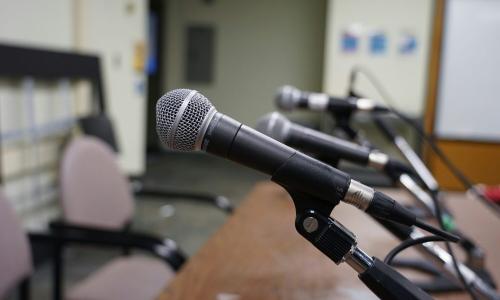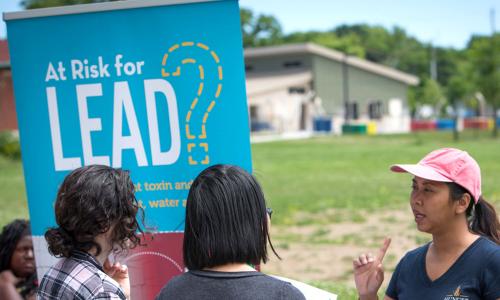The Trump administration is relentlessly attacking science. Its targets include federal science advisory committees, which work to ensure that the best available data, evidence, and science inform government decisions that affect us all.
Historically, the president and agency leaders have relied on these public forums for independent advice from as many as 80,000 experts outside the government. The Trump administration, however, is disbanding, pausing, or otherwise disrupting federal advisory committees and other independent scientific bodies. In just its first six months, the administration shut down 51 of almost 200 active science advisory committees, with more under review for potential elimination.
These actions harm the nation because they deprive the public and government of reliable and robust science advice to inform decision making on everything from air pollution protections to vaccine and drug approvals to investments that protect communities from the growing impacts of climate change.
The good news is that we can do something about it: Establish science infrastructure outside of government to ensure that essential science advice remains available for those who need it. Here we provide the essential information and resources you need to get started.
Are you a member of a disbanded advisory committee?
You can continue your committee’s work independently and ensure that the best available science continues. To help you get started, we’ve created a toolkit for scientists to continue the work of dismantled federal science advisory committees, along with a range of other resources (below).
Are you a former federal employee?
If you are a former government employee with knowledge of the Federal Advisory Committee Act (FACA) and how to run a scientific advisory committee, consider volunteering to support an independent science initiative in need of facilitation, outreach and engagement, administrative, or other logistical support. You may also be able to identify science activities no longer happening in the federal government that would benefit from being run independently. A number of currently active initiatives to engage with and gain inspiration from are listed below.
Are you a scientist or science supporter?
You can track committees that provide advice on issues relevant to your scientific discipline or general areas of interest; the FACA Database is a good place to start (learn more about how to use the database). Committees that are still active have a mandate to operate openly and transparently, and provide opportunities for the public to attend, submit comments, and share their own lived experience and expertise to inform committee recommendations.
If a committee you care about has been eliminated or idled, highlight the impacts of its loss to your elected officials through direct outreach or by writing a letter to the editor in your state or local news outlet. Engage with other experts in your discipline and work with your scientific society to ensure science advice can continue as best as possible.
Now is the time for action.
The Trump administration’s ongoing effort to suppress, undermine, or eliminate science cannot stand. With your help, the scientific community can rise to meet this moment and intervene to defend and preserve essential scientific work, strengthen science infrastructure outside of government, and prevent the permanent weakening of scientific innovation, expertise, and talent in the United States.
Key resources
- DOWNLOAD: How-to Guide: Running an Independent Science Advisory Committee
- WATCH: Preserving Federal Science Advice: Opportunities for Independent Science Advisory Committees (May 2025)
- Learn more about independent science efforts currently underway
- Using the Federal Advisory Committee Act (FACA) Database to help set up your independent advisory committee
- Do you have additional questions or information to share about independent scientific work currently underway? Email us at independentscience@ucs.org.
Additional resources
- Scientists’ Role in Defending Democracy, co-authored by UCS President and CEO, Gretchen Goldman (Science, August 2025)
- Eliminating US science advisory committees will harm the public and open the door to special interests (Bulletin of Atomic Scientists, May 2025)
- Learn more about our federal advisory committee work on the UCS blog, The Equation.
- Abandoning Science Advice: One Year in, the Trump Administration Is Sidelining Science Advisory Committees (January 2018)
- Scientific Integrity of Federal Advisory Committees: Recommendations for 2021 and Beyond (2020)
- Safeguarding Against Distortions of Scientific Research in Federal Policymaking (2021)
- The Role of Scientists and Engineers on Advisory Committees (Science Network Workshop Series, 2016)
Frequently asked questions on running an independent scientific advisory committee
If my committee has been terminated, how do I find previous charges, meeting materials, the latest membership roster, and other information?
Some committee websites still host this information, but if the website has been archived or erased, you can try to find the materials on the Internet Archive using the Wayback Machine. You can also access some formal committee materials and information on members and deliverables on the Government Services Administration’s FACA Database. (Learn more about how to use the FACA database.) If neither of these options work for you, you can try reaching out to the Designated Federal Officer for your committee or the home agency’s Committee Management Officer (full list here).
If my committee has not been disbanded, but many of the members have been fired before their terms were set to end, how can we continue to be productive independent of the formal committee?
You can continue to track the committee as it brings on new members and begins meeting again. You and your committee members can participate individually or as a group to review the committee’s charges, meeting deliberations, and recommendations and hold them accountable for using the best available science and incorporating a diverse and balanced set of perspectives. Depending on your capacity and interest among members, you could set up a coordinated response effort and deliberate in your own virtual or in-person meetings, or you can participate by submitting public comments and presenting them at the committee’s regularly scheduled meetings.
What are some expectations for committee members to keep in mind as they volunteer for this effort?
Setting up an independent advisory committee means that you are not operating under the official FACA rules, but there are still parts of federal advisory committee requirements that can and should be adopted to uphold the credibility and integrity of your group. It’s important for members of the committee to commit to review meeting materials in advance of meetings and coming prepared to exchange views and perspectives and search for consensus-based solutions and to maintain an environment that promotes open discussion and equitable participation. Additionally, members should keep in mind that science advice should be free from conflicts of interest and appearance of impartiality, so if there are known conflicts on any issues that the committee is discussing, members should be transparent and proactively elect to recuse themselves.
If not all committee members have signed on, but we’d like to add new committee members whose expertise would help balance the committee, what are some best practices on how to do this?
Try to find the membership balance plan for your committee or look at the charter and your current composition and try to fill gaps with the right amount of technical expertise and lived experience. If you are missing key representatives from industry or state or local government, make sure you have a fair balance of viewpoints and backgrounds. You can also review guidance material from the General Services Administration.
What are some best practices for conducting a conflict of interest review for new members?
You can use the Office of Government Ethics (OGE) Form 450 for Special Government Employees as a template for how you might document and track conflicts from committee members. These forms are required for all members of federal advisory committees that join as “special government employees.” You can review OGE guidance for analyzing potential conflicts of interest and guidance on appointments from the General Services Administration.
Can we use and post charge documents and other materials that were circulated to committee members from the home agency?
The Federal Advisory Committee Act requires advisory committees to make advisory committee documents available to the public, including meeting agendas, pre-decisional materials such as drafts, working papers and studies, meeting minutes and transcripts, reports and studies, and other documents prepared for or by an advisory committee. Often these materials are stored or archived on the committee’s webpages and/or in the FACA database. In some cases, there may be some pre-decisional and privileged documents that are exempted from disclosure. For more information, you can review the General Services Administration guidance on this topic.
How can we get the word out about the committee meeting that would have otherwise been posted in the federal register?
Posting it on a webpage and sharing it on social media (LinkedIn, Instagram, X, Bluesky) are options. You can also ask committee members to share meeting information with their networks, including scientific associations. You can review previous committee meeting minutes, especially the public comments, and reach out to organizations, companies, government representatives, and individuals who have commented in the past. You can also share the meeting notice with elected officials who are on relevant House and Senate committees and with reporters who cover issues relevant to the committee’s recommendations.
What are some logistics to consider for a virtual meeting?
For a virtual meeting, you will need to host the meeting over a web conferencing platform such as Zoom or Teams. The Federal Advisory Committee Act required at least 15 days of notice in advance of a committee meeting, but you should provide at least a month of advance notice if possible. If you are providing opportunities for members of the public to comment, make sure that you share an agenda with the public comment period time clearly listed so they can choose to join only for that portion of the meeting. You should make sure that you have a meeting transcript application running or a person who can take notes and create a meeting minutes document. You may consider livestreaming your zoom meeting on Youtube.
What are some logistics to consider for an in-person or hybrid meeting?
The Federal Advisory Committee Act requires at least 15 days notice in advance of a committee meeting, but you should provide at least a month of advance notice, if possible. To keep costs down for an in-person committee meeting, consider hosting using a meeting room at a committee member’s institution or a community center, library, or a partner’s office building in a location central to committee members or in a place that is easily accessed by airport and rail. Ideally, the event space will have teleconferencing ability and A/V equipment to accommodate those committee members and members of the public who are unable to travel. You should make sure that you have a meeting transcription application running or a person who can take notes and create a meeting minutes document. You may consider livestreaming your zoom meeting on Youtube.
How many meetings should our committee hold?
You can keep to the estimated number of annual meetings in your committee’s charter or you can decide as a committee to hold more or less than that based on the type of work you expect to work on together and the demand for recommendations from end users outside of the federal government.
What are some ways we can make sure that decisionmakers and other end users know about and can find our recommendations and proceedings?
You can invite journalists, partner organizations, and members of Congress to attend and cover the meeting. You may also consider publishing a summary of your recommendations to a journal in a relevant field. If you have a webpage, you can post the meeting materials and final recommendations and share widely within the networks of committee members and the state, local, and Tribal governments, and other organizations that may benefit from your work. If there is an upcoming agency decision or rulemaking that the committee feels would benefit from its recommendations, consider submitting a comment and posting the recommendations to the regulatory docket.




